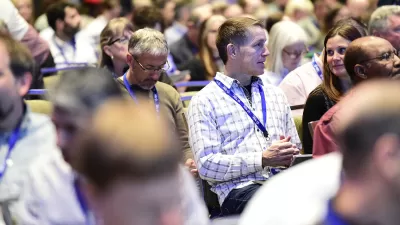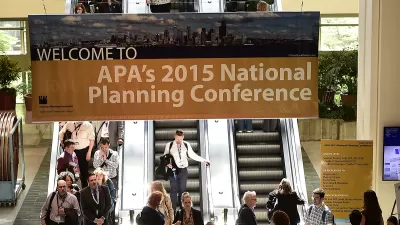A session at the recent APA National Conference in Chicago gathered together the heads of the major built-environment professional organizations to discuss their unique and shared challenges. One subject was on each head's mind: Water.
What is the most critical issue designers don't even know exists? "According to the heads of the major built-environment design organizations, the American Society of Landscape Architects (ASLA), the American Institute of Architects (AIA), and the American Planning Association (APA), it’s water," says Jared Green, who recaps the Presidents Forum held at the recent APA National Conference.
"Water is going to become increasingly scarce. It’s particularly a problem in the United States as many of the highest growth areas are in parts of the country that are already stressed with water shortages. Worldwide, countries are struggling with diminishing ground water resources and some are even worried about water wars. Mitchell Silver, the outstanding (and unfortunately outgoing) president of APA, said 'water is going to make oil look minor league.'” This was among the critical insights provided at the unique gathering of design profession luminaries that included Mark Focht, FASLA and Jeffrey Potter, FAIA.
Other prominent issues confronting each field:
ASLA: "The focus of the next few years will be pushing for land and water conservation, community parks, a national complete streets program, more federal support for green infrastructure, and benefits for small businesses."
AIA: "Potter said the architecture practice was in a state of transformation. He said the world is struggling with how to create 'place-based knowledge in a digital era'....In this new world, architects are increasingly focused on 'high performance places, public health, and disaster mitigation.'”
APA: "With 40,000 members in 90 countries, APA is also concerned about global issues like climate change, population growth, urbanization, and suburbanization....The future then is about 'comprehensive planning' to ensure communities are more 'adaptable and resilient' to changes, whether they are due to population growth, water shortages, economic change, climate shifts, or natural disasters."
FULL STORY: What Is the Most Critical Issue Designers Don’t Even Know Exists?

Planetizen Federal Action Tracker
A weekly monitor of how Trump’s orders and actions are impacting planners and planning in America.

Maui's Vacation Rental Debate Turns Ugly
Verbal attacks, misinformation campaigns and fistfights plague a high-stakes debate to convert thousands of vacation rentals into long-term housing.

Restaurant Patios Were a Pandemic Win — Why Were They so Hard to Keep?
Social distancing requirements and changes in travel patterns prompted cities to pilot new uses for street and sidewalk space. Then it got complicated.

In California Battle of Housing vs. Environment, Housing Just Won
A new state law significantly limits the power of CEQA, an environmental review law that served as a powerful tool for blocking new development.

Boulder Eliminates Parking Minimums Citywide
Officials estimate the cost of building a single underground parking space at up to $100,000.

Orange County, Florida Adopts Largest US “Sprawl Repair” Code
The ‘Orange Code’ seeks to rectify decades of sprawl-inducing, car-oriented development.
Urban Design for Planners 1: Software Tools
This six-course series explores essential urban design concepts using open source software and equips planners with the tools they need to participate fully in the urban design process.
Planning for Universal Design
Learn the tools for implementing Universal Design in planning regulations.
Heyer Gruel & Associates PA
JM Goldson LLC
Custer County Colorado
City of Camden Redevelopment Agency
City of Astoria
Transportation Research & Education Center (TREC) at Portland State University
Jefferson Parish Government
Camden Redevelopment Agency
City of Claremont




























